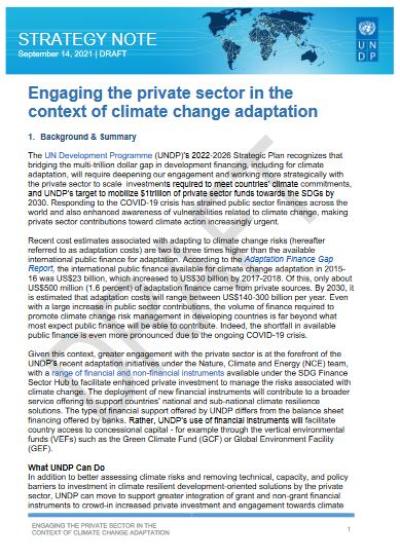Strategy Note: Engaging the private sector in the context of climate change adaptation

The UN Development Programme (UNDP)’s 2022-2026 Strategic Plan recognizes that bridging the multi-trillion dollar gap in development financing, including for climate adaptation, will require deepening our engagement and working more strategically with the private sector to scale investments required to meet countries’ climate commitments, and UNDP’s target to mobilize $1trillion of private sector funds towards the SDGs by 2030. Responding to the COVID-19 crisis has strained public sector finances across the world and also enhanced awareness of vulnerabilities related to climate change, making private sector contributions toward climate action increasingly urgent.
Recent cost estimates associated with adapting to climate change risks (hereafter referred to as adaptation costs) are two to three times higher than the available international public finance for adaptation. According to the Adaptation Finance Gap Report, the international public finance available for climate change adaptation in 2015-16 was US$23 billion, which increased to US$30 billion by 2017-2018. Of this, only about US$500 million (1.6 percent) of adaptation finance came from private sources. By 2030, it is estimated that adaptation costs will range between US$140-300 billion per year. Even with a large increase in public sector contributions, the volume of finance required to promote climate change risk management in developing countries is far beyond what most expect public finance will be able to contribute. Indeed, the shortfall in available public finance is even more pronounced due to the ongoing COVID-19 crisis.
Given this context, greater engagement with the private sector is at the forefront of the UNDP’s recent adaptation initiatives under the Nature, Climate and Energy (NCE) team, with a range of financial and non-financial instruments available under the SDG Finance Sector Hub to facilitate enhanced private investment to manage the risks associated with climate change. The deployment of new financial instruments will contribute to a broader service offering to support countries’ national and sub-national climate resilience solutions. The type of financial support offered by UNDP differs from the balance sheet financing offered by banks. Rather, UNDP’s use of financial instruments will facilitate country access to concessional capital - for example through the vertical environmental funds (VEFs) such as the Green Climate Fund (GCF) or Global Environment Facility (GEF).
